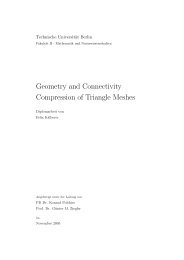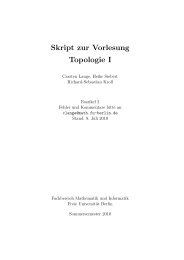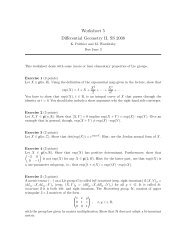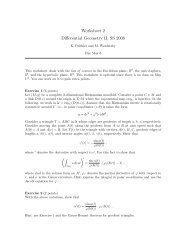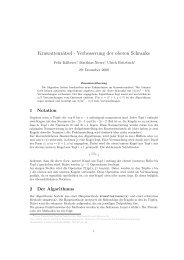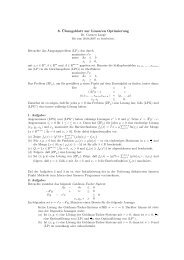Exercise Sheet 5
Exercise Sheet 5
Exercise Sheet 5
You also want an ePaper? Increase the reach of your titles
YUMPU automatically turns print PDFs into web optimized ePapers that Google loves.
Prof. Dr. Konrad Polthier:<br />
Differential Geometry I<br />
<strong>Exercise</strong> <strong>Sheet</strong> 5<br />
due Nov 22nd 2011<br />
Dr. C. Lange<br />
Dipl.-Math. St. W. von Deylen<br />
<strong>Exercise</strong> 17 (3 pts.). Consider S 2 = {(x, y, z) ⊤ ∈ R 3 | x 2 + y 2 + (z − 1) 2 = 1}. A<br />
coordinate system is given by the stereographic projection π : S 2 \ {N} → R 2 which<br />
maps a point p = (x, y, z) ⊤ of S 2 minus the north pole N = (0, 0, 2) ⊤ to the intersection<br />
of the xy-plane with the straight line connecting N and p.<br />
(i) Show that π −1 : R 2 → S 2 is given by<br />
π −1 (u, v) =<br />
2<br />
u2 +v2 2u<br />
2v<br />
+4 u2 +v2 <br />
.<br />
(ii) Compute the first fundamental form of the S 2 \{N} with respect to the parametrization<br />
π −1 .<br />
<strong>Exercise</strong> 18 (3 pts.). Let γ(t) = (r(t), 0, h(t)) ⊤ be a regular parametrized curve in the<br />
xz-plane that does not meet the z-axis. Recall that a surface of revolution is obtained<br />
by rotating γ around the z-axis and can be parametrized by<br />
f(t, ϕ) =<br />
r(t) cos ϕ<br />
r(t) sin ϕ<br />
h(t)<br />
(i) Derive formulae for the second fundamental form, the principal curvatures/directions,<br />
the mean curvature, and the Gaussian curvature.<br />
(ii) For 0 < r < R, consider the Frenet curve γ : [0, 2π] → 3 <br />
cos t<br />
, t ↦→ sin t with Frenet<br />
0<br />
frame (T |N|B) and the set<br />
Tr,R = γ(t) + r (cos(ϕ)N(t) + sin(ϕ)B(t)) ∈ 3 | 0 < t, ϕ < 2π <br />
Give a parametrization of Tr,R as a surface of revolution rotated around the z-axis<br />
and compute the corresponding second fundamental form.<br />
<strong>Exercise</strong> 19 (2 pts.). Show that for any point p on a surface S, the mean curvature H<br />
is given by<br />
H(p) = 1<br />
2π<br />
κN(ϕ) dϕ,<br />
2π 0<br />
where κN(ϕ) is the normal curvature at p in direction of an angle ϕ with respect to a<br />
fixed direction.<br />
<strong>Exercise</strong> 20 (3 pts.). Let r(t) = aet and h(t) = t √<br />
0 1 − a2e2x dx for some constant<br />
a ∈ . The resulting surface of revolution is called a pseudosphere.<br />
Determine the asymptotic lines and the curvature lines for the pseudosphere and show<br />
that the Gaussian curvature is −1 everywhere.<br />
Visualize the asymptotic and curvature line with the help of a computer (optional).<br />
<br />
.
Prof. Dr. Konrad Polthier:<br />
Differentialgeometrie I<br />
Übungsblatt 5<br />
Abgabe: 22. November 2011<br />
Dr. C. Lange<br />
Dipl.-Math. St. W. von Deylen<br />
Aufgabe 17 (3 Pkte.). Betrachten Sie die Einheitssphäre S 2 = {(x, y, z) ⊤ ∈ R 3 | x 2 +<br />
y 2 + (z − 1) 2 = 1}. Durch die stereographische Projektion π : S 2 \ {N} → R 2 ist<br />
ein Koordinatensystem gegeben, welches einen Punkt p = (x, y, z) ⊤ von S 2 ohne den<br />
Nordpol N = (0, 0, 2) ⊤ auf den Schnittpunkt von xy-Ebene und der Strecke von N<br />
nach p abbildet.<br />
(i) Zeigen Sie, daß π −1 : R 2 → S 2 gegeben ist durch<br />
π −1 (u, v) =<br />
2<br />
u 2 +v 2 +4<br />
2u<br />
2v<br />
u 2 +v 2<br />
(ii) Berechnen Sie die erste Fundamentalform von S 2 \ {N} bezüglich der Parametrisierung<br />
π −1 .<br />
Aufgabe 18 (3 Pkte.). Sei γ(t) = (r(t), 0, h(t)) ⊤ eine reguläre parametrisierte Kurve in<br />
der xz-Eben, welche die z-Achse nicht schneidet. Erinnern Sie sich, daß durch Rotation<br />
von γ um die z-Achse eine Rotationsfläche erzeugt wird, die parametrisiert werden kann<br />
durch<br />
<br />
r(t) cos ϕ<br />
f(t, ϕ) = r(t) sin ϕ .<br />
h(t)<br />
(i) Berechnen Sie die zweite Fundamentalform, die Hauptkrümmungen und Hauptkrümmungsrichtungen,<br />
die mittlere und die Gauß-Krümmung von f.<br />
(ii) Betrachten Sie für 0 < r < R die Frenet-Kurve γ : [0, 2π] → 3 <br />
cos t<br />
, t ↦→ sin t mit<br />
0<br />
Frenet-Rahmen (T |N|B) und die Menge<br />
Tr,R = γ(t) + r (cos(ϕ)N(t) + sin(ϕ)B(t)) ∈ 3 | 0 < t, ϕ < 2π .<br />
Geben Sie eine Parametrisierung von Tr,R als Rotationsfläche um die z-Achse an<br />
und berechnen Sie die zugehörige zweite Fundamentalform.<br />
Aufgabe 19 (2 Pkte.). Zeigen Sie, daß für jeden Punkt p einer Fläche S die mittlere<br />
Krümmung H gegeben ist durch<br />
H(p) = 1<br />
2π<br />
2π<br />
0<br />
κN(ϕ) dϕ,<br />
worin κN(ϕ) die Normalkrümmung in p in Richtung eines Winkels ϕ mit einer beliebigen,<br />
fest gewählten Richtung im Tangentialraum ist.<br />
Aufgabe 20 (3 Pkte.). Sei r(t) = aet und h(t) = t √<br />
0 1 − a2e2x dx für eine Konstante<br />
a ∈ . Die resultierende Rotationsfläche heißt Pseudosphäre.<br />
Bestimmen Sie die Asymptotenlinien und die Krümmungslinien der Pseudosphäre und<br />
zeigen Sie, daß die Gauß-Krümmung überall −1 ist.<br />
Visualisieren Sie Krümmungs- und Asymptotenlinien mithilfe eines Computer-Plots (optional).<br />
<br />
.




